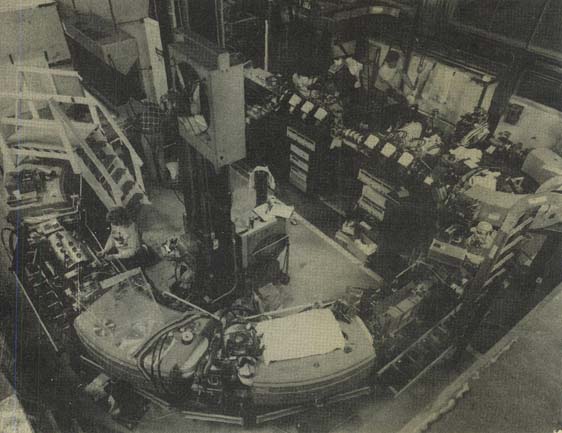Fermilab Builds Proton Accelerator to Treat Cancer
The U.S. Department of Energy's Fermi National Accelerator Laboratory at Batavia has announced the first successful operation of a small proton accelerator to treat rare cancers. It was designed and built at Fermilab for Loma Linda University Medical Center in California, where it will be used to treat cancer and other diseases by focusing a beam of protons to eradicate diseased cells.

Fermilab employees work on the new proton therapy accelerator. The new synchotron will be used for the treatment of cancer and other diseases. Designed and built at Fermilab, it will be disassembled and moved to Loma Linda University Medical Center in California. Fermilab will continue to operate its neutron therapy facility for cancer treatment.
The first operation is an important step in a 1986 agreement between the medical center and Fermilab, according to Fermi officials.
Under the agreement the accelerator will be disassembled and moved to Loma Linda during the summer of 1989 when the critical facilities for the treatment of patients are ready. In the interim Fermilab will continue start-up procedures although it will not be used to treat patients, Fermilab will continue accepting patients in its neutron therapy facility.
The proton therapy accelerator is 20 feet in diameter -- the world's smallest proton synchrotron -- and will deliver a variable energy of 70 to 250 MeV (million electron volts). In comparison, the Fermilab Tevatron -- the world's largest -- is 4 miles in circumference and delivers energies of approximately l trillion electron volts.
Use of protons for cancer therapy was first proposed by Robert Wilson, the first Fermilab director, immediately after World War II while he was at Harvard University. Pioneering work has been carried out for many years at the Harvard Cyclotron Laboratory built by Wilson at the Lawrence Berkeley Laboratory at the University of California in Berkeley, and at laboratories in Sweden, the Soviet Union and recently in Japan. All of this work has made use of accelerations originally built for scientific research and later adapted for cancer therapy.
The work has proved that proton therapy has significant advantages over other methods of cancer treatment such as X-rays or neutrons. The greatest advantage is that the proton beam limits the radiation dose to the disease site, reducing the side effects of treatment while killing disease cells.
The new accelerator built at Fermilab is the first designed specifically for therapy. It has several special features, such as precise energy control and long beam spill that are included to make therapy easier and more efficient.
The facility at Loma Linda will have four treatment rooms, three with gantries to bring the beam to the disease site from any desired angle and one specialized room for treatment of the head and neck. It will be possible to treat many more patients than has been possible in the past. New treatment aids planning methods are being developed in the center.


